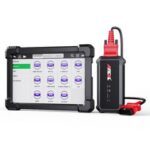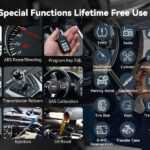Is your Nissan Note displaying a check engine light? Understanding your vehicle’s On-Board Diagnostic (OBD) system is the first step to resolving car troubles. Modern vehicles like the Nissan Note are equipped with an OBD-II system that monitors various components and systems, alerting you to potential issues through indicator lights and stored diagnostic trouble codes (DTCs). To access these valuable codes, you’ll need to locate the OBD-II port in your Nissan Note. This article will guide you to find this port and understand how it can help you diagnose common car problems.
What is an OBD-II Port and Why is it Important?
The OBD-II port is a standardized interface in virtually all cars manufactured since 1996. It acts as a communication gateway between your vehicle’s computer and diagnostic tools. Mechanics and car owners alike use this port to connect OBD-II scanners or code readers to retrieve DTCs, which are essentially codes that pinpoint potential malfunctions.
Why is this important? Because understanding these codes can save you time and money. Instead of guessing what’s wrong when a warning light illuminates, you can use an OBD-II scanner to get a more specific idea of the problem. This allows for more informed decisions about repairs and maintenance. For Nissan Note owners, knowing the OBD-II port location is crucial for both proactive maintenance and when those unexpected warning lights appear.
Locating the OBD-II Port in Your Nissan Note
Finding the OBD-II port in your Nissan Note is usually straightforward. While exact placement can slightly vary depending on the model year, it’s typically located in the driver’s side footwell area.
Here’s a step-by-step guide to help you find it:
- Driver’s Side Footwell: Get into the driver’s seat of your Nissan Note.
- Under the Dashboard: Look under the dashboard, near the steering column. You’ll be searching for a 16-pin, trapezoid-shaped connector.
- Knee Area: Often, it’s positioned around knee level or slightly above. You might need to crouch down slightly to get a clear view.
- Free of Obstruction: The port is generally not hidden behind panels, although it might be tucked away. It should be easily accessible without tools.
- Use a Flashlight (If Needed): If it’s dark or you’re having trouble seeing clearly, use a flashlight to illuminate the area under the dashboard.
Once you’ve located the OBD-II port, you’re ready to connect a compatible scanner and begin diagnosing your Nissan Note.
Decoding Common OBD-II Trouble Codes for Your Nissan
Once you’ve connected your OBD-II scanner, it will retrieve any stored trouble codes. These codes are standardized across the automotive industry, but understanding what they mean in the context of your Nissan Note is essential.
Here are some common OBD-II trouble codes that you might encounter in your Nissan, along with potential issues:
| Code | Common Problems That Trigger This Code

